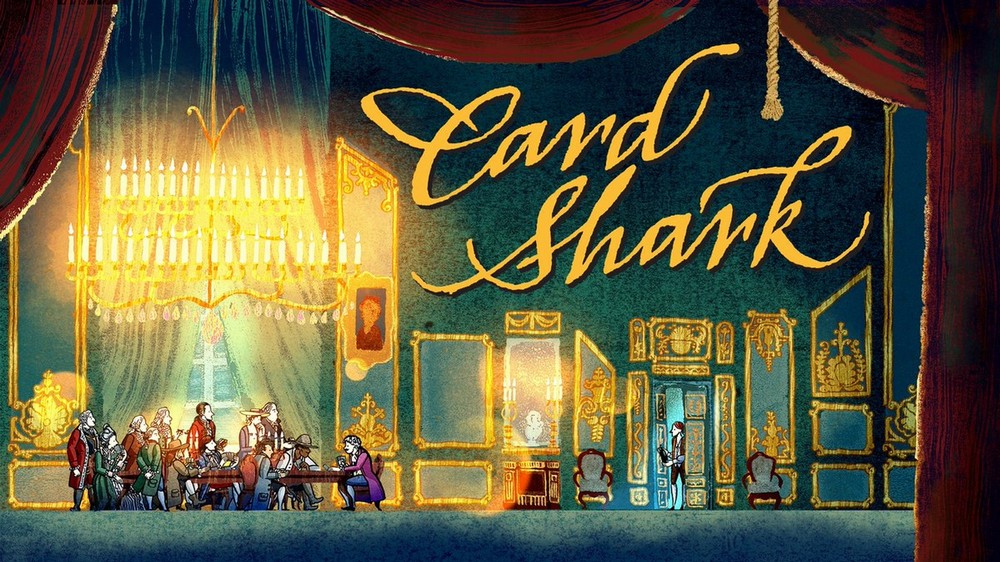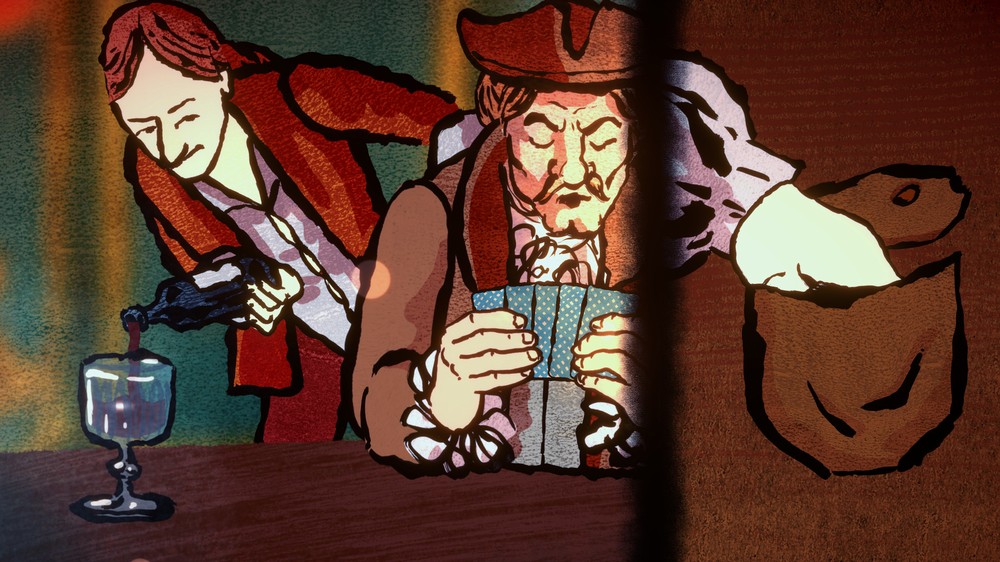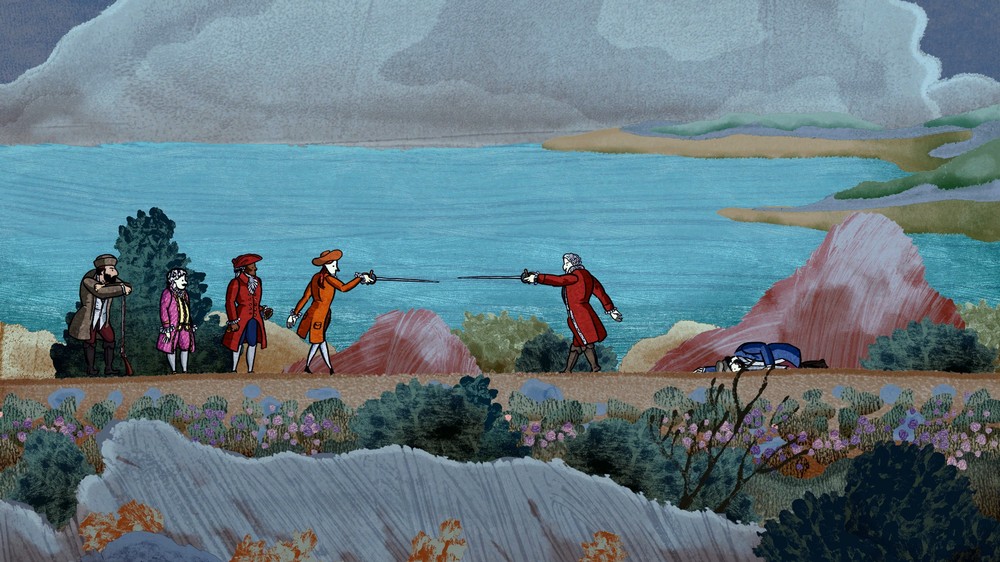When I was young, my first introduction to poker was in the minigames in New Super Mario Bros. Of course, I was like eight at the time and didn’t really understand it very well, and it was a bit simplified, with no suits and only six symbols. But it was pretty much poker all the same. You played for coins against the green-clad plumber across from you, as various mushroom-headed guys roam around in the background with trays of drinks and such.
Playing Card Shark is somewhat similar to that, but instead of playing as the unseen player, or Famous Video Game Character Luigi, you play as one of the toads, in particular one who’s helping someone cheat the game hard, scamming people for all they’re worth. Also, it’s 18th century France, and you are a mute who definitely is not part mushroom, but otherwise it’s the same thing honestly. You can pet the dog at least!
 The player controls an unnamed and voiceless protagonist who travels alongside a Romani caravan in the company of a gentleman referred to as Comte de Saint-Germain, a brilliant con artist. He is here to relieve fools from their money and donate a large sum of it to the caravan, who in turn donates it to worthy causes such as orphanages and whatnot. You are pulled into his schemes with promises of a way to make some quick and easy money, and then things escalate.
The player controls an unnamed and voiceless protagonist who travels alongside a Romani caravan in the company of a gentleman referred to as Comte de Saint-Germain, a brilliant con artist. He is here to relieve fools from their money and donate a large sum of it to the caravan, who in turn donates it to worthy causes such as orphanages and whatnot. You are pulled into his schemes with promises of a way to make some quick and easy money, and then things escalate.
You see! It turns out that fools with loads of money, despite being fools, are not oblivious, and are also quite fond of their money. Should some such potential marks decide that you and your partner in crime happen to be a bit too lucky, well. They may decide to take their money back over your dead bodies. Which is less than ideal.
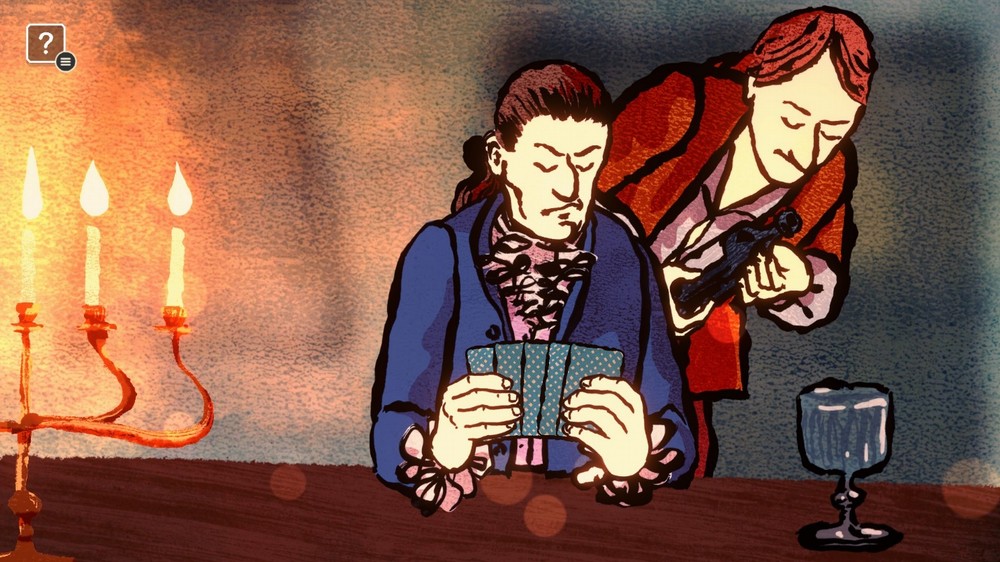 The gameplay starts off fairly simple. You are taught a series of tricks and maneuvers that I am fairly certain could be used to actually cheat at cards in real life, executing them via a series of carefully timed button presses and joystick wiggles. Of course, pressing buttons and wiggling your joystick will make others suspicious, but early on stages will end before that becomes an issue.
The gameplay starts off fairly simple. You are taught a series of tricks and maneuvers that I am fairly certain could be used to actually cheat at cards in real life, executing them via a series of carefully timed button presses and joystick wiggles. Of course, pressing buttons and wiggling your joystick will make others suspicious, but early on stages will end before that becomes an issue.
However, as things progress, you will learn more varieties of tricks that require different skills. While you start off gently pouring wine to peek at cards and rigging Three Card Monty, as you progress you will learn much more complex and difficult ways to cheat, such as stacking a deck with extra cards (which works great as long as you remember what cards you added so you can remove them before people see the extras).
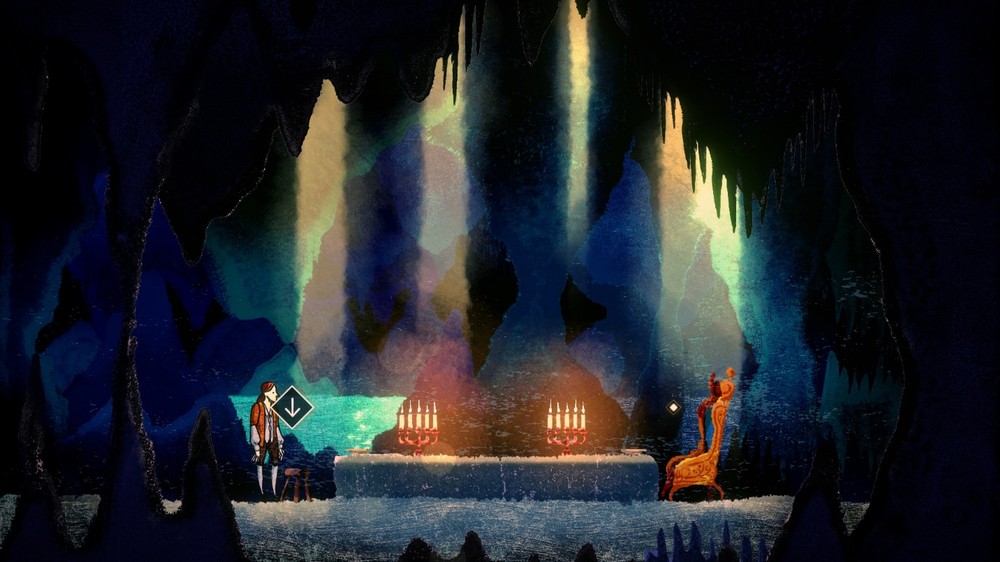 The gameplay takes a bit to get going, but when it does it feels pretty darn great to execute. It helps that the story is intriguing, and the art is drop dead gorgeous. The choice to have a literally mute protagonist is novel as well! Most games choose to have silent protagonists to better immerse the player, but I have never seen a game host a character who is literally unable to speak on the same level as the rest of the cast. Dialog trees are presented in the form of a picture of a facial expression or gesture, in addition with a short descriptor of what it’s supposed to mean or how it’s supposed to come across. It’s a nice system, and the representation is good as well.
The gameplay takes a bit to get going, but when it does it feels pretty darn great to execute. It helps that the story is intriguing, and the art is drop dead gorgeous. The choice to have a literally mute protagonist is novel as well! Most games choose to have silent protagonists to better immerse the player, but I have never seen a game host a character who is literally unable to speak on the same level as the rest of the cast. Dialog trees are presented in the form of a picture of a facial expression or gesture, in addition with a short descriptor of what it’s supposed to mean or how it’s supposed to come across. It’s a nice system, and the representation is good as well.
However, the game does have a few flaws that I found a bit difficult to ignore. The first one is relatively minor, but as such will hopefully be fixed in the release version: As you are learning the trick with the bottle, you are instructed to wipe the table in specific patterns in order to indicate certain suits. However, when you pause and look at the quick reference guide, two of the inputs (the ones for vertical and horizontal wiping) are switched, and as such will give an improper response if you go relying on the guide. This is mitigated by the fact that the game does tell you what symbol it says you’re indicating before you submit it, but still somewhat annoying.
 The other two are a bit more of a hindrance: there is no cutscene skip. This is not much of a problem if you can perform flawlessly and win each level the first time you go through it. However, the final level in the demo has very high stakes and comes with some lengthy cutscenes before you actually get to the playing part. If you fail the level, you will die. And dying in this game is not as simple as picking “retry” on a menu.
The other two are a bit more of a hindrance: there is no cutscene skip. This is not much of a problem if you can perform flawlessly and win each level the first time you go through it. However, the final level in the demo has very high stakes and comes with some lengthy cutscenes before you actually get to the playing part. If you fail the level, you will die. And dying in this game is not as simple as picking “retry” on a menu.
When you die, you go to the underworld and must play a game with Death herself. If you win, you get resurrected and can continue from the start of the mission (with a cutscene of the characters talking about how spooked you look). However, if you fail, you must either pay with all of your money to be resurrected (which means you need to spend some time running a Three Card Monty game to earn money back with), or let your soul be eaten. This deletes your save file.
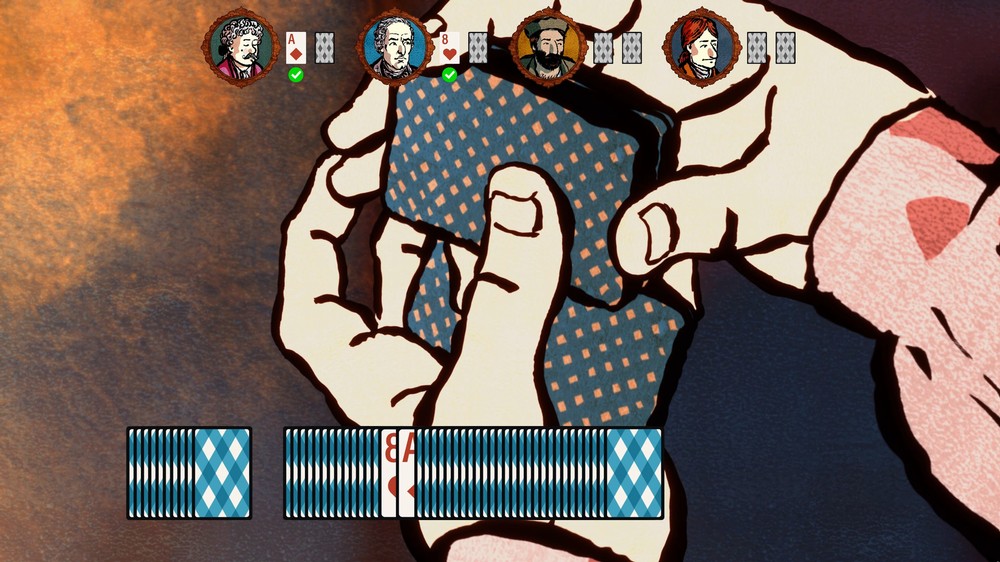 If you do come out with your save intact from an encounter with Death, she will allow you to resurrect for free in future attempts of that stage. However, you still need to sit through the cutscenes, as well as the scene of her telling you that you need not play with her again for now.
If you do come out with your save intact from an encounter with Death, she will allow you to resurrect for free in future attempts of that stage. However, you still need to sit through the cutscenes, as well as the scene of her telling you that you need not play with her again for now.
In itself, this wouldn’t be a huge issue either, perhaps even with the unskippable cutscenes. However, there is a mechanic that is never fully explained (and downright necessary for the final stage), wherein if you fail part of a task in an inconspicuous manner and it results in your sidekick losing the hand, it reduces an opponent’s suspicion. However, doing so will lose you money for obvious reasons, and not having enough money to continue playing counts as a loss. The buy-in cost of hands increases over time, and isn’t something you always have control over, so this can be a bit frustrating.
Otherwise though, Card Shark is a truly unique and intriguing game with beautiful art and a compelling story. The way all of the tricks you use to rig games are fairly realistic and require no complex setup helps really set the mood, and the game’s atmosphere is fantastic, despite a few frustrating details. I recommend giving this one a look.

